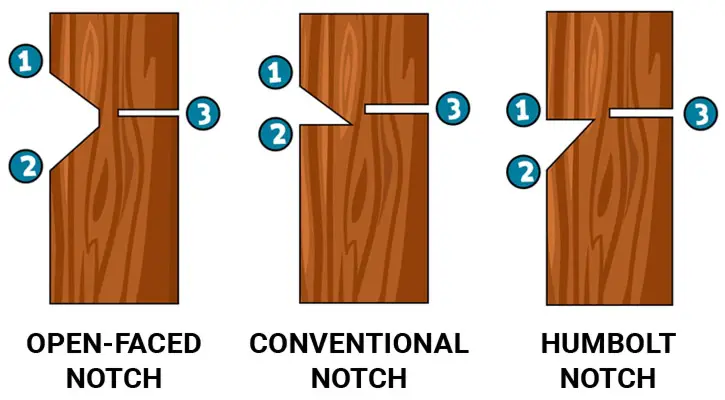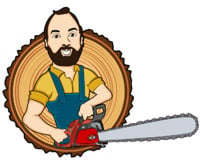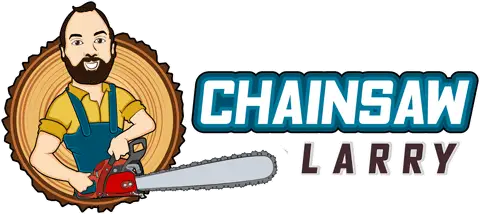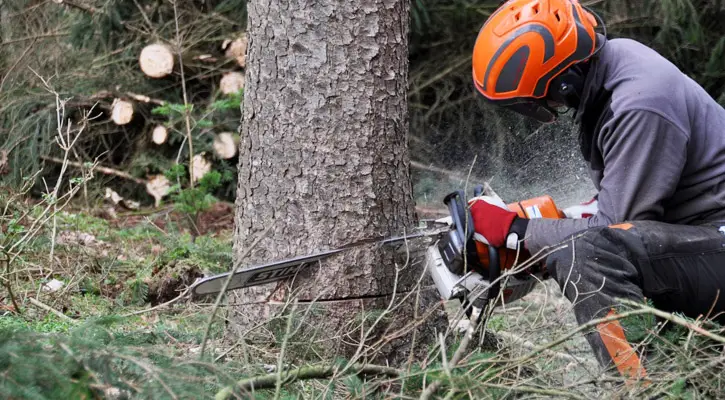Table of Contents
So you need to cut down a tree?
Maybe you have two or three?
But not sure exactly how to do it?
Well, before you fire that chainsaw up, it’s good to know what you’re doing.
In this post, I’ll teach you everything you need to know about how to cut down a tree with a chainsaw. This process is also referred to as “felling” a tree.
So, I’ll also teach you how to fell a tree with a chainsaw.
Cutting down (or felling) a tree may seem like an easy task when the tree is small, but once you start taking down taller pines and oaks, it gets a bit complicated.
Felling a tree with a chainsaw takes crucial planning and thought before you go at it. Otherwise, you may cause yourself or those around you to get injured.
But don’ worry, I’ll make sure you know everything necessary for this job so it will go as smooth as possible.
Don’t Have a Chainsaw Yet?
If you’re reading this guide and don’t already own a chainsaw, then I invite you to check out my list of the top chainsaws.
That post will help you find the best chainsaw to take down trees that meets your specific needs.
You’ll learn about the various types of chainsaws, which features makes each one stand out, and find reviews of the top 10 chainsaws you can buy today.
I also have another post on the best 18 inch chainsaws which are ideal for cutting down the average size tree. And a free guide on the best chainsaw for cutting firewood, if you’re going to use the tree you’re cutting down for heat.
So, give them a quick look.
It’s worth it just to even see what chainsaws are out there.

First, Preparing to Cut Down a Tree
Get the Proper Permits (If Required)
One thing I need to mention up front is that some areas have strict environmental regulations.
That means, you can’t just go around cutting down trees with your chainsaw.
If the tree you want to fell is on your own property, you’re likely to be fine. But, if it’s in a neighbors yard or another piece of land, then you’ll want to make sure you get any of the necessary permits (or permission) to take down the tree.
Check with your local tree commission if you have any doubts.
Make the Necessary Preparations
When cutting down trees, safety always comes first.
Tall trees are extremely heavy and you don’t want to make the mistake of taking down a house, barn, power line, fence, or other structure along with the tree by accident.
Therefore, when you’re preparing to fell a tree with a chainsaw, take note of which objects and structures are in the vicinity.
If there are any public areas or chances for people to walk (or drive) through the location, put up warning signs so they can be aware that active logging is taking place.
You also want to pay attention to the other trees as well. It’s not uncommon for a tree to have a ripple effect with other trees when it comes crashing down. This can lead to all sorts of danger and even a bigger mess to clean up.
Try to imagine all possible scenarios before cutting with your chainsaw.
Also, make sure you’re wearing the right protective equipment too.
If you don’t have a high-quality pair of safety glasses, gloves, hearing protection, chaps, helmet, etc., then take a look at my chainsaw safety equipment reviews to see the top gear that’s available.
Pick a Direction for the Tree to Fall
After you’ve surveyed the area and feel confident that you’re not going to cause any damage to structures (or injuries to people), you can now figure out which direction you want to fell the tree.
If the tree is already leaning in one direction, it may be best to just let it naturally fall that way when you cut it down. That is if there are no objects within the fall zone.
The fall zone is the area directly in the path of the tree when it comes down. For small to medium sized trees, you may be able to measure the vertical height and then get an accurate distance of how much space it will cover when felled on the ground horizontally.
For really tall trees that are not measurable, you’ll need to make your best guess by eyeballing it.
Regardless of the height, if the tree is not leaning in one particular direction, then you can usually pick any direction for it to fall. Just keep in mind how easy or difficult it will be for you to complete the job while working in the fall zone.
For example, if the tree is next to a stream, you may not want to let it fall in that direction since cutting that portion of the timber could be difficult.
Clear Your Getaway Path
When you cut down a tree, you need to get away from it fast—and at a good distance—to ensure your safety.
The best direction for you to go is at a 90-degree angle from the fall. This will keep you out of the felling zone and the side where the trunk separates from the stump.
So, before you start felling the tree with your chainsaw you first need to make sure that the area around the tree and your getaway path is clear of debris and other obstacles.
Once the tree starts falling, you don’t want to be dodging other trees, fallen limbs, rocks, or other objects.
Your safety must always come first.
Remove Low Branches
If the tree your cutting down has any branches that are shoulder height or lower, then you’ll want to remove those before you actually fell the tree.
Removing these branches will give you the clearance you need to more easily use the chainsaw on the tree. It will also help to eliminate any close snapping wood that could ricochet off the ground and fly back toward you.
A good safety tip here is to work at an angle that puts the tree trunk between you and the chainsaw when removing the lower branches. Also, never cut anything higher than your shoulders. That’s a recipe for disaster and can cause serious injuries since you don’t have good control at those heights.
How to Cut Down a Tree with a Chainsaw
When it comes to how to cut down a tree with a chainsaw, you have three options. And each one uses three cuts to make what’s called a “notch”.
The type of notch you choose to fell a tree is personal preference.
Each method of notching achieves the same end result. So, pick the one that seems most logical to you, and over time, try out each type of notch on other trees so you can find the one you like best.

Cuts 1 and 2: Face Cuts
The first two cuts you need to learn for how to fell a tree with a chainsaw are the face cuts.
Two face cuts make a notch.
The notch is made on the side of the tree that faces the direction you want it to fall.
A comfortable height for making face cuts is about 24 inches from the ground. And you want to saw to a depth of about 20-25% of the tree’s diameter.
If you’re right-handed, notch the face cuts on the right side of the trunk. If you’re left-handed, make the face cuts on the left.
There are three types of face cuts you can choose between:
- Open-Faced Notch: This is a wide cut that’s ideally 90-degrees, but can be as small as 70-degrees.
- Conventional Notch: This is a cut that’s at a 45-degree angle. The top part of the cut is angled downward while the bottom part is flat.
- Humbolt Notch: This cut is a reverse of the Conventional Cut. The top part of the cut is flat while the bottom part is at an angle upward, creating an upside down 45-degree angled notch.
Cut 3: Back Cut
Once the front notch is cut, you can then make the back cut with your chainsaw.
The back cut is what disconnects the tree from the stump and creates a hinge for the tree to fall.
The width of the back cut should be about 10% of the diameter of the tree trunk. Stop cutting when you’re a few inches away from the notch.
The back cut is made on the opposite side of the notch and exact height will depend on the type of notch you chose:
- Open-Faced Notch: The back cut should be made at the same height as the corner of the notch.
- Conventional Notch: The back cut should be at least 1 inch above the bottom cut.
- Humbolt Notch: The back cut should be at least 1 inch above the top cut.
Once you’ve made the back cut with your chainsaw, the tree may start to fall. If so, stay calm, keep your eyes on the tree and move away quickly.
If the tree is still upright, then you’ll want to use a felling wedge to make the tree begin to fall. The felling wedge acts as a lever that gives the tree a push in the right direction for it to tip over.
Insert the wedge into the back cut and tap it with a sledge hammer until the tree starts to fall.
If the Tree Becomes Lodged During the Fall
Sometimes a tree may become lodged or stuck in another tree when it’s on the way down.
If that happens, the best thing you can do is get help from an experienced logger.
Using your chainsaw to try and cut a lodged tree or the tree that it is stuck in can pose a lot of danger. So, it’s best that you don’t attempt this type of thing without professional help.
If you must leave the tree to go find help, rope off the area so that anyone who passes by is aware of the possible danger of a falling tree. Like always, safety comes first when it comes to cutting down trees.
Check out the Top Selling Chainsaws
Now that you know how to cut down a tree with a chainsaw, you may be wanting to buy your first chainsaw or upgrade an existing tool.
If either of those is the case, I invite you to check out my list of the top chainsaws. It includes the top 10 chainsaws you can by today sorted by type: gas powered, battery operated, and electric.
I also have a dedicated page on the best 18 inch chainsaws which are an excellent length for felling medium to large size trees. They also make a good size for cutting firewood, which you can learn more about in this guide on the best chainsaw for cutting firewood.
Take a quick look at those posts to get a feel for the kinds of chainsaws you can get for cutting down trees.
I hope you enjoyed this guide on how to fell a tree with a chainsaw.
Good luck!

Your pal,
Chainsaw Larry

